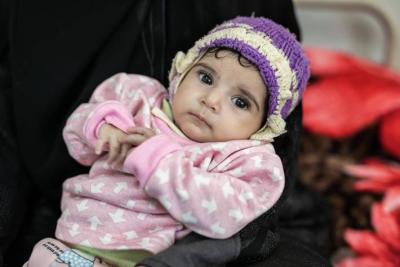The spokesperson for the UN Secretary-General, Stéphane Dujarric, warned that 2.3 million children in Yemen are at risk of famine according to current projections.
Dujarric explained during a press conference that the humanitarian aid plan for Yemen is insufficiently funded, having received only $1.9 billion of the $3.4 billion budget required in 2020. According to the UN, Yemenis are experiencing the worst humanitarian crisis in the world, with nearly 80 percent of the total population—approximately 24.1 million people—needing some form of humanitarian assistance. Four UN agencies warned today that nearly 2.3 million children under five in Yemen are expected to suffer from acute malnutrition in 2021. Additionally, 400,000 of these children are expected to suffer from severe acute malnutrition, with a risk of death if they do not receive urgent treatment.
The new figures, included in the latest report on acute malnutrition from the Integrated Food Security Phase Classification released today by the Food and Agriculture Organization (FAO), UNICEF, the World Food Programme (WFP), the World Health Organization (WHO), and their partners, indicate a 16% and 22% increase in rates of acute and severe acute malnutrition, respectively, among children under five compared to 2020.
UN agencies warned that these figures are among the highest rates of severe acute malnutrition recorded in Yemen since the escalation of conflict in 2015. UNICEF Executive Director Henrietta Fore stated that the rising number of children suffering from hunger in Yemen should compel all of us to act. Fore emphasized that more children will die with each passing day without necessary actions, highlighting the need for humanitarian organizations to secure urgent, predictable resources and ensure unobstructed access to local communities on the ground in order to save lives.
The Director-General of the FAO, Qu Dongyu, noted that Yemeni families have found themselves trapped in conflict for a long time, with recent risks like the coronavirus only exacerbating their plight. Dongyu pointed out that unless security and stability are achieved throughout the country and better access is provided to farmers to equip them with the means to resume cultivating sufficient nutritious food, Yemen's children and families will continue to sink deeper into levels of hunger and malnutrition.
WFP Executive Director David Beasley regarded these figures as another call for help from Yemen, emphasizing that each malnourished child indicates a family struggling to survive. Beasley confirmed that the crisis in Yemen is a lethal mix of conflict, economic collapse, and acute funding shortages necessary to deliver life-saving assistance, noting that solving hunger entails ensuring food availability and stopping violence. If action is taken now, there is still time to end the suffering of Yemen's children.
WHO Director-General Dr. Tedros Adhanom Ghebreyesus remarked that diseases and poor health environments are major factors causing malnutrition in children. At the same time, malnourished children are more susceptible to diseases like diarrhea, respiratory infections, and malaria, which are of great concern in Yemen, among other issues. It is often a deadly vicious cycle, but through relatively low-cost and simple interventions, many lives can be saved.
Rates of acute malnutrition among young children and mothers in Yemen are increasing with each year of conflict, while 2020 saw significant deterioration due to rising rates of diseases such as diarrhea, respiratory infections, cholera, and increased food insecurity. Among the most affected governorates are Aden, Al-Dhale, Hajjah, Al-Hudaydah, Lahij, Taiz, and the city of Sana'a, which collectively account for more than half of the expected cases of acute malnutrition in 2021.
Today, Yemen is one of the most dangerous places in the world for children to grow up, suffering from high rates of infectious diseases, limited access to routine immunization and healthcare services for children and families, unhealthy practices in infant and young child feeding, and inadequate sanitation and hygiene systems. Meanwhile, the already fragile healthcare system is grappling with the repercussions of COVID-19, which has drained scarce resources and resulted in fewer patients seeking medical care.
The dire situation for children and mothers in Yemen means that any disruption in humanitarian services—from health to water, sanitation and hygiene, nutrition, food aid, and livelihood support—could lead to a deterioration of their nutritional status. Humanitarian response remains critically underfunded, with the humanitarian response plan for 2020 receiving $1.9 billion against the required $3.4 billion.




